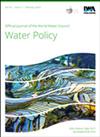Household water insecurities and willingness to pay in Karachi
IF 1.8
4区 环境科学与生态学
Q4 WATER RESOURCES
引用次数: 0
Abstract
This study highlights various challenges faced by households in accessing safe and reliable water in Karachi, Pakistan's largest city. Using data collected from a stratified random sample of 990 households across Karachi's six districts in 2021–2022, our findings reveal disparities in pipeline coverage, sewage mixing, and water supply. Pipeline coverage is the highest in high-income neighborhoods (99%) and the lowest in low-income areas (71%). Low-income households experience more sewage mixing (76%) than high-income households (55.38%). Overall, 60% of households report frequent sewage mixing, and 30% have had someone in their household contract a water-borne illness in the last 6 months. Approximately half of the households are dissatisfied with water service, with a median daily water supply of just 8 min (equivalent to 56 minutes per week). We find that households that received some water supply in the past month are 11% more likely to pay their bills. Nevertheless, households demonstrate a substantial willingness to pay (WTP) for improvements in the piped water system. The median monthly WTP is PKR 500 for low-income households, PKR 1,000 for middle-income households, and PKR 1,700 for high-income households. Our analysis emphasizes the importance of income-sensitive interventions in urban water supply management in the Global South.卡拉奇家庭用水不安全与支付意愿
这项研究强调了巴基斯坦最大城市卡拉奇的家庭在获得安全可靠的水方面面临的各种挑战。利用从2021-2022年卡拉奇六个地区990个家庭的分层随机样本收集的数据,我们的研究结果揭示了管道覆盖、污水混合和供水方面的差异。管道覆盖率在高收入社区最高(99%),在低收入地区最低(71%)。低收入家庭的污水混合率(76%)高于高收入家庭(55.38%)。总体而言,60%的家庭报告经常发生污水混合,30%的家庭在过去6个月内有人感染了水传播疾病。大约一半的家庭对供水服务不满意,平均每天的供水时间只有8分钟(相当于每周56分钟)。我们发现,在过去一个月获得一些供水的家庭支付账单的可能性要高出11%。尽管如此,家庭还是表现出很大的意愿,愿意为改善管道供水系统而付费。低收入家庭的月收入中位数为500卢比,中等收入家庭为1000卢比,高收入家庭为1700卢比。我们的分析强调了对收入敏感的干预措施在发展中国家城市供水管理中的重要性。
本文章由计算机程序翻译,如有差异,请以英文原文为准。
求助全文
约1分钟内获得全文
求助全文
来源期刊

Water Policy
环境科学-水资源
CiteScore
3.10
自引率
12.50%
发文量
81
审稿时长
6-12 weeks
期刊介绍:
Water Policy will publish reviews, research papers and progress reports in, among others, the following areas: financial, diplomatic, organizational, legal, administrative and research; organized by country, region or river basin. Water Policy also publishes reviews of books and grey literature.
 求助内容:
求助内容: 应助结果提醒方式:
应助结果提醒方式:


